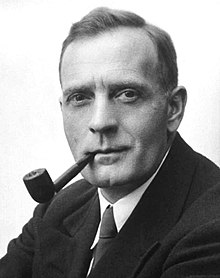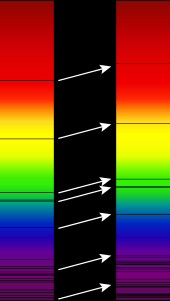Edwin Hubble
Edwin Powell Hubble (November 20, 1889 – September 28, 1953) was an American astronomer. Hubble's findings changed the scientific view of the universe.
Edwin Powell Hubble | |
|---|---|
 | |
| Born | November 20, 1889 |
| Died | September 28, 1953 (aged 63) San Marino, California, U.S. |
| Nationality | American |
| Alma mater | University of Chicago University of Oxford |
| Known for | Big Bang Hubble's law Redshift Hubble sequence |
| Awards | Bruce Medal 1938 |
| Scientific career | |
| Fields | Astronomy |
| Institutions | University of Chicago Mount Wilson Observatory |
| Influenced | Allan Sandage |

Career
changeIn 1925 he showed that there are galaxies beyond our own, the Milky Way.[1][2] Also, he developed a method for classifying galaxies.
Then he proved the galaxies were moving away from each other. Hubble found the degree of Doppler effect (redshift) from a galaxy increased in proportion to its distance from Earth. Doppler effect is the change in pitch or colour when an object or sound comes in (higher pitch, brighter color) or moves away (lower and darker). Redshift is observed in the light spectrum
In 1929 Hubble formulated what is called Hubble's law. The law states that the greater the distance between any two galaxies, the greater their relative speed of separation. Georges Lemaître, a Belgian priest and astronomer, had published the idea two years before in an obscure journal.[3][4] Nevertheless, the idea bears Hubble's name to this day.[5]
Today, the 'apparent velocities' of galaxies are understood as an increase in proper distance which occurs due to the expansion of space. Light traveling through stretching space experiences a Hubble-type redshift.[6]
This work helped to establish that the universe is expanding. Some have incorrectly said that Hubble discovered the Doppler shift in the spectra of galaxies, but this had already been observed earlier by Vesto Slipher, whose data Hubble used.
The Hubble Space Telescope was named after Hubble.
Four major achievements
changeAccording to Sandage, Hubble achieved four main things:[6]
- A classification system for nebulae, both galactic (diffuse) and extragalactic (both nebulae inside our Milky Way galaxy, and other galaxies outside it).
- Hubble settled decisively the question of the nature of the galaxies (as being other things like the Milky Way).
- The distribution of galaxies was found to be homogeneous in distance (the galaxies were all over the universe, not in any particular location).
- The linear velocity-distance relation was established. This discovery lead to the notion of the expanding universe which is the centre-piece of the cosmology of the present day.
Hubble's personal opinion on the data
changeHubble himself did not see his 1929 data as evidence for an expanding Universe. Even six years later, Hubble wrote:
"… if redshifts are velocity shifts which measure the rate of expansion, the expanding models are definitely inconsistent with the observations that have been made … expanding models are a forced interpretation of the observational results"
— E. Hubble, Ap. J., 84, 517, 1936 [7]
"[If the redshifts are a Doppler shift] … the observations as they stand lead to the anomaly of a closed universe, curiously small and dense, and, it may be added, suspiciously young. On the other hand, if redshifts are not Doppler effects, these anomalies disappear and the region observed appears as a small, homogeneous, but insignificant portion of a universe extended indefinitely both in space and time."
— E. Hubble, Monthly Notices of the Royal Astronomical Society, 97, 513, 1937 [8]
Inflation as an explanation for expansion
changeHubble's words were forgotten, and the notion of the expansion of the universe became the consensus. Until the theoretical developments in the 1980s no one had an explanation for why this seemed to be the case. The question "why is the universe expanding?" is now answered by understanding the details of what happened in the first inflationary epoch (10−32 seconds) of the existence of our universe.
References
change- ↑ Marcia Bartusiak (2010). The day we found the Universe. Random House Digital, Inc. pp. x–xi. ISBN 9780307276605.
- ↑ Hubble, Edwin (December 1926). "Extragalactic nebulae". Astrophysical Journal. 64 (64): 321–369. Bibcode:1926ApJ....64..321H. doi:10.1086/143018.
- ↑ Eugenie Samuel Reich Published online 27 June 2011| Nature| doi:10.1038/news.2011.385
- ↑ Livio, Mario (9 November 2011). "Lost in translation: Mystery of the missing text solved". Nature. 479 (7372): 171–173. Bibcode:2011Natur.479..171L. doi:10.1038/479171a. PMID 22071745. S2CID 203468083 – via www.nature.com.
- ↑ Nussbaumer, Harry 2013. 'Slipher's redshifts as support for de Sitter's model and the discovery of the dynamic universe' In Origins of the Expanding Universe: 1912–1932. Astronomical Society of the Pacific. pp. 25–38. [1]
- ↑ 6.0 6.1 Sandage, Allan 1989. Edwin Hubble 1889–1953, The Journal of the Royal Astronomical Society of Canada, Vol. 83, No.6. Retrieved 2010-03-26.
- ↑ Effects of red shifts on the distribution of nebulae, Hubble, Edwin 1937. Astrophysical Journal, 84, p517. The SAO/NASA Astrophysics Data System
- ↑ Red-shifts and the distribution of nebulae, Hubble, Edwin 1937. Monthly Notices of the Royal Astronomical Society, 97, p513. The SAO/NASA Astrophysics Data System.